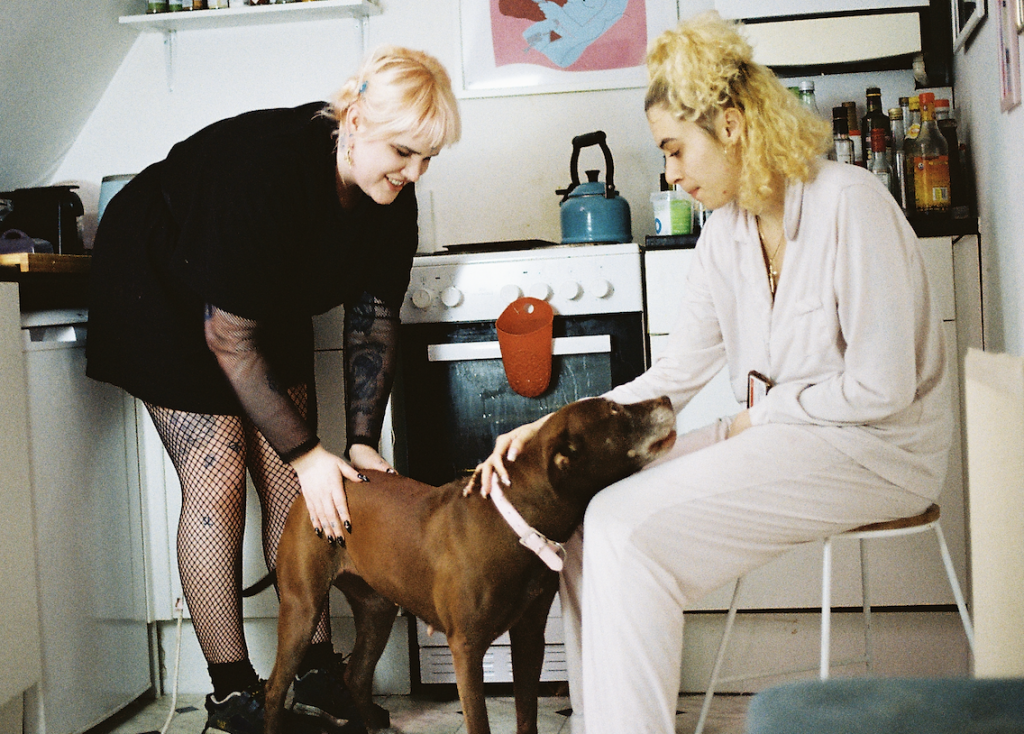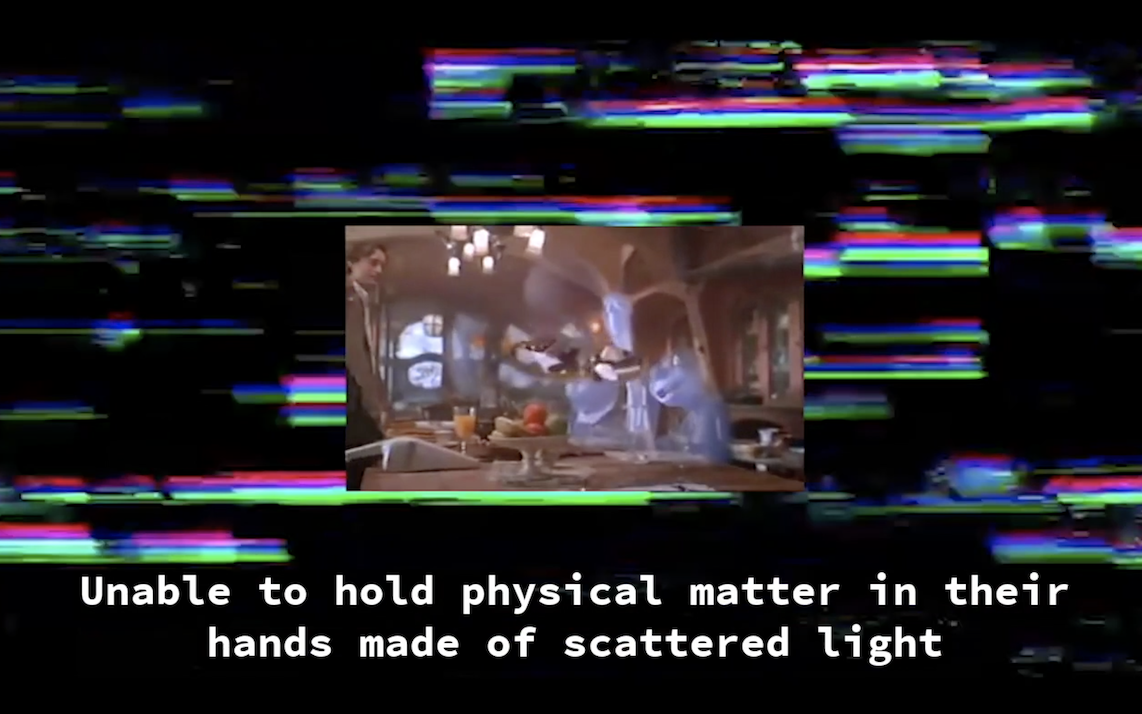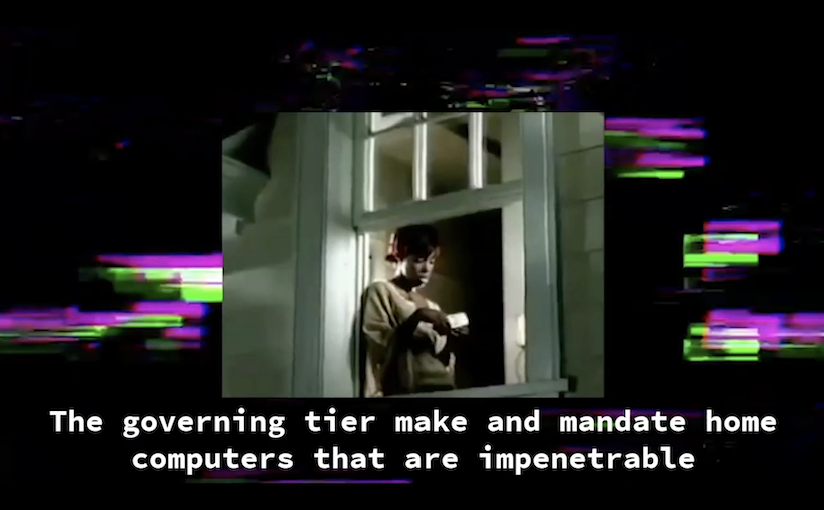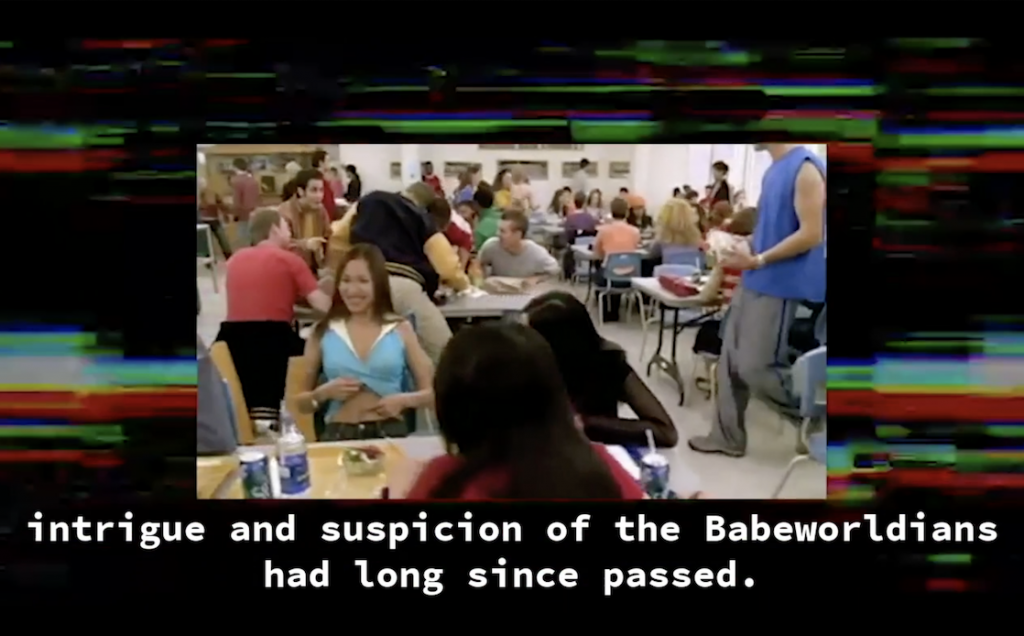In Steven Spielberg and Ian Watson’s 2001 film, A.I. Artificial Intelligence, the maltreatment of ‘Mecha’ child robot, David, represents a dilemma over humanity at odds with its technological mirror image. Abandoned by his adoptive parents when their biological son awakens from a coma, he’s captured by a bounty hunter and tortured for public entertainment. Georgina Tyson and Ashleigh Williams’ collaborative Babeworld project encompasses a variety of catchy millennial adages, resource guides on structural inequality, and an art practice that concerns social identities, the internet, and new models for inclusivity. As sex workers, Williams and Tyson frequently take stances on the topic, with their own Hollywood-referencing film AI: Artificial Intimacy on disembodied selves and dehumanization in online performance settings. The video captures a humanoid sex robot slowly deviating away from its creator’s intended design.
For Spielberg’s AI, the crowd is spurred by anxiety and over-speculation to protest David’s plight, booing and throwing trash at his captors in demand of his release. “He looks like a boy!” shouts a woman from the rafters, to which a bounty man counters, “We are only demolishing artificiality!” This psychological haywire comes out of friction between humanity and its artificial Self—a paradox wherein the reflection remains constant, while simultaneously re-charting. Babeworld seeks to address this tension.
For Czech curatorial platform PAF’s London festival curated by Anne Duffau on November 29, the duo contributed Rise of the Babeworldians, an autobiographical moving image piece on a incorporeal species crash-landing into capitalist society.
**How did Babeworld come about, was there a particular reason you started collaborating?

Babeworld: It began as a single project that we worked on together, just for fun, in the living room of our shared house on a pink velvet Habitat couch Ashleigh found on Gumtree. The two of us had been living together for a while. As we got to know more about each other in the little downtime we had between university and work, we recognised similarities in our experiences of class, sex work and art education. Both somewhat stagnant in our respective practices, we created this space to make, write, and share. It was a pairing that happened naturally, as we both bring different skills, and yet share the same ideals and goals.
**Your contribution to PAF London concerns corporeality in that the Babeworldians are without bodies. How does that relate to the ideas of sex and technology within your previous works?
Bw: I don’t think it does. In previous works concerning sex and technology, there’s always an emphasis on the physicality, like very visceral sounds of bodily functions, extreme close ups of usually sexualised body parts, and crudely detailed descriptions of sexual acts. The main concern when discussing sex in conjunction with technology is desensitisation. When we discuss our own experiences in this context, we rely heavily on the physical to evoke and humanise. Specifically, in regards to sex work, where 90 percent of client-provider interactions are online, which enables clients to separate the persona they are communicating with from the people we are—thereby dehumanising.
The Babeworldians, however, came from something else, probably the normative expectation of showing up physically that we feel should change. Working in most industries during a worldwide pandemic has disembodied a large portion of the world’s population. Something we have learned from this is how we have always had the resources to accommodate things—like working from home or hosting art events online.
At Babeworld, we have been utilising social media and technology to create work, share work, and network in an effort to make our art and our platform accessible. What we wanted to express through the Babeworldians was that the community and space we had procured had been an alien concept before the pandemic forced traditionalist art institutions to embrace it. We are just two millennials that grew up with the internet and had our finger on the digitally-coded pulse. So, technology is always a motif, aesthetic and reference point for anything we make.

**Is that influenced at all by your understanding of ‘post-internet species’? What does that mean exactly?
Bw: Rise of the Babeworldians is semi autobiographical, so in reality, we are post-internet artists who make work that mainly exists online. However, in this imagined reality, we are a post-internet species where our connection to and advocacy of online communities is taken so far to the extreme we cease to function as anything other than an online presence. It expresses our appreciation for the opportunities the internet has afforded us while also raising concerns about the dark side of the internet—as it still exists heavily interfered with (and influenced by) capitalism and colonialism.
**The social media performance site OnlyFans saw upwards of 200,000 users joining every day in May. Are platforms like this similar to the sex robots you discuss in your whorling.net piece? Are they manufacturing something?
Bw: Platforms like OnlyFans had existed and been used by sex workers long before. These clip-selling sites had already been using features like direct messaging. Purchasing sexual services (whether digital or IRL) have always needed a way to be customisable per client. Personas of sex workers providing services are malleable—constantly in flux, depending on a client’s wants and needs, within reason and limits, of course. It’s a personalised experience where the provider’s main goal in the client’s satisfaction, which can take many forms. This could be a scripted video, where the client is the scriptwriter, a phone call where the provider takes the role of someone the client desires, a physical meeting where the client decides on the provider’s overall appearance.
Usually the client is leading and taking an active role in constructing the fantasy, and is aware that it wouldn’t be happening if there was no financial transaction. However, sex work doesn’t exist within a vacuum. Intimacy is complicated, and lines can blur, as described in the piece, AI: Artificial Intimacy. To believe that the popularisation of OnlyFans* is driving us down a path that ultimately ends in artificial intimacy and progressing past the need for genuine and physical connection would be erasing the work and impact full-service sex workers, without whom OnlyFans wouldn’t even exist. Not to mention that transactional and artificial intimacy has been a massive part of society since the dawn of time. It has and will continue to take on many forms.

It’s important to note that sex workers use OnlyFans, and sex workers popularized it, but the platform itself doesn’t support sex workers. It has demonstrated recently with the Bella Thorne situation, and it demonstrates it daily with over-the-top censorship and the removal of sex workers from the website. It is also important to note that the increase in users joining came from full-service sex workers who lost their jobs during lockdown. They were disproportionately affected by the government’s lack of financial assistance, with the only aid coming from sex work charities and community-driven fundraising. As it entered the mainstream, the celebrities treating it like a cash grab, disregarding how sex workers are affected by their presence on the site, had people believe it was an easy way for people to make money, which inflated user sign ups.
**Community seems to be a focal point of Babeworld, can you talk about that? What defines your community?
Bw: We had both been feeling disconnected from the art world that was sold to us in art education. We had both experienced a lack of diversity in our peers and the teaching staff, which led to isolation and feeling misunderstood. Through discussing these feelings together and then sharing these thoughts online, we were connected with other people that felt the same way. The majority of our projects over the last couple of years have included members of our communities, as we believe it’s important to extend any platform we are given to other marginalised people. This gives us the opportunity to exercise accessibility within the institutions and art world we once felt disenfranchised from; to set an example of how resources should be used and how accessible creating accessibility is.

**Back to your PAF London presentation, how is community different than the corporatist society the Babeworldians are corrupting?
Bw: Community is inclusion and togetherness—a space where differences aren’t barely tolerated but accepted or even celebrated. Diversity in all sectors is necessary to ensure systems and processes that keep society functioning fairly and ethically have everyone’s best interests. The Babeworldians role and goal in this particular story are to aid the disadvantaged and oppressed in connecting with each other again so that they can form communities based on their own needs and desires. Rather than the needs and desires of a biased and influenced corporatist society.
**Last question—where did the Babeworldians come from?
Bw: The planet Babeworld is not unlike this version of Earth the Babeworldians crash landed on—existing in a neighbouring reality where their technological advancements are only marginally more progressed due to a major event that took the planet on a different course to this new planet. It was 2018, and the 10th season of Ru Paul’s Drag Race was recording its fifth episode. Fabrics were laid out—differing prints in muted tones reflective of the country theme of this week’s runway. Monique Heart’s hand hovers over a white print with small, brown, angular spots until her attention is caught by another fabric in her periphery. The brown spots were larger and less severe—rounded at the edges like the patterned flesh of a brown cow. ‘Stunning’, she thought to herself.**
share news item

